 DETROIT – General Motors will offer 18 flexible fuel vehicles (FFVs) in model year 2009. The number of E85 compatible vehicle models available in 2009 is a sharp increase from the past following the group’s commitment to making their line at least half E85 compatible by 2012.
DETROIT – General Motors will offer 18 flexible fuel vehicles (FFVs) in model year 2009. The number of E85 compatible vehicle models available in 2009 is a sharp increase from the past following the group’s commitment to making their line at least half E85 compatible by 2012.
“We continue to believe that biofuels, specifically E85, is the most significant thing we can do in the near-term to offset future energy demands,” said Beth Lowery, GM vice president of Environment, Energy and Safety Policy. “We are on target to make 50 percent of our vehicles flex-fuel capable by 2012 providing the infrastructure is in place.”
The models cover the gamut from the four-cylinder Chevrolet HHR small crossover to the full-size Cadillac Escalade ESV luxury utility.
Infrastructure includes both the availability of the E85 fuel and stations where it is sold. Currently, there are more than 1,600 E85 stations thorughout the U.S.
GM cars and trucks account for 3 million of the 7 million flex-fuel vehicles on U.S. roadways and the company produced more than 1 million flex-fuel models in North America and Brazil last year.
Below is the listing of 2009 models GM offers that include flex-fuel capability at no additional charge to the customer:
Chevrolet: Avalanche, Express, HHR, HHR Panel, Impala, Silverado, Suburban, Tahoe
GMC: Savana, Sierra, Yukon, Yukon XL
Cadillac: Escalade, Escalade ESV, Escalade EXT
Hummer: H2, H2 SUT
Buick: Lucerne
“We are pleased to see the increasing number of models of FFVs that General Motors will be offering during model year 2009 and are especially excited about the new 4 cylinder addition to their E85 model lineup,” stated Executive Director of the NEVC, Phil Lampert.
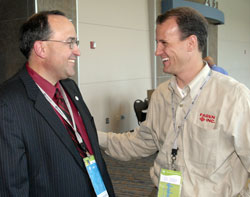 Another representative of Fagen Incorporated has joined the ranks in the Ethanol Promotion and Information Council. Matt Sederstrom of Platinum Ethanol is a new board member, elected at EPIC’s first annual meeting earlier this month.
Another representative of Fagen Incorporated has joined the ranks in the Ethanol Promotion and Information Council. Matt Sederstrom of Platinum Ethanol is a new board member, elected at EPIC’s first annual meeting earlier this month.

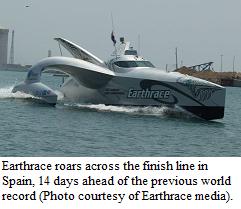 Sixty days after it left port in Sagunto, Spain… and 14 days ahead of the previous world record… the 100 percent biodiesel-powered boat, Earthrace, has finished circling the globe faster than any other boat ever has before.
Sixty days after it left port in Sagunto, Spain… and 14 days ahead of the previous world record… the 100 percent biodiesel-powered boat, Earthrace, has finished circling the globe faster than any other boat ever has before.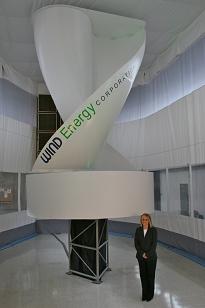 While big wind farms are part of the U.S. Department of Energy’s plan to have wind power make up 20 percent of the nation’s energy supply by 2030. But at least one small wind power generator is saying, “Don’t forget about the little guys.”
While big wind farms are part of the U.S. Department of Energy’s plan to have wind power make up 20 percent of the nation’s energy supply by 2030. But at least one small wind power generator is saying, “Don’t forget about the little guys.”

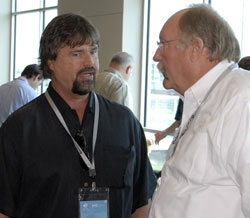 Gary Pestorious (pictured speaking with EPIC founder Ron Fagen) isn’t new to ethanol nor to the
Gary Pestorious (pictured speaking with EPIC founder Ron Fagen) isn’t new to ethanol nor to the 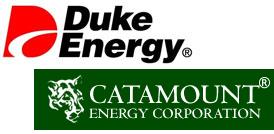 One of the nation’s largest power companies has added to its wind energy holdings. Charlotte, North Carolina-based Duke Energy has spent $240 million to acquire Vermont-based wind energy company Catamount Energy Corp.
One of the nation’s largest power companies has added to its wind energy holdings. Charlotte, North Carolina-based Duke Energy has spent $240 million to acquire Vermont-based wind energy company Catamount Energy Corp. A North Dakota commission is recommending that ethanol, biodiesel and wind play a larger role in that state’s energy future.
A North Dakota commission is recommending that ethanol, biodiesel and wind play a larger role in that state’s energy future. Over the next five years, Tuscon, Arizona will be buying more biodiesel buses for the city’s public transportation system.
Over the next five years, Tuscon, Arizona will be buying more biodiesel buses for the city’s public transportation system. Louisiana Governor Bobby Jindal this week signed into law the Advanced Biofuel Industry Development Initiative, the most comprehensive and far-reaching state legislation in the nation enacted to develop a statewide advanced biofuel industry. Louisiana is the first state to enact alternative transportation fuel legislation that includes a variable blending pump pilot program and a hydrous ethanol pilot program.
Louisiana Governor Bobby Jindal this week signed into law the Advanced Biofuel Industry Development Initiative, the most comprehensive and far-reaching state legislation in the nation enacted to develop a statewide advanced biofuel industry. Louisiana is the first state to enact alternative transportation fuel legislation that includes a variable blending pump pilot program and a hydrous ethanol pilot program.